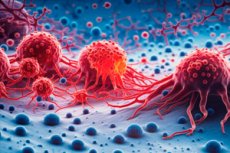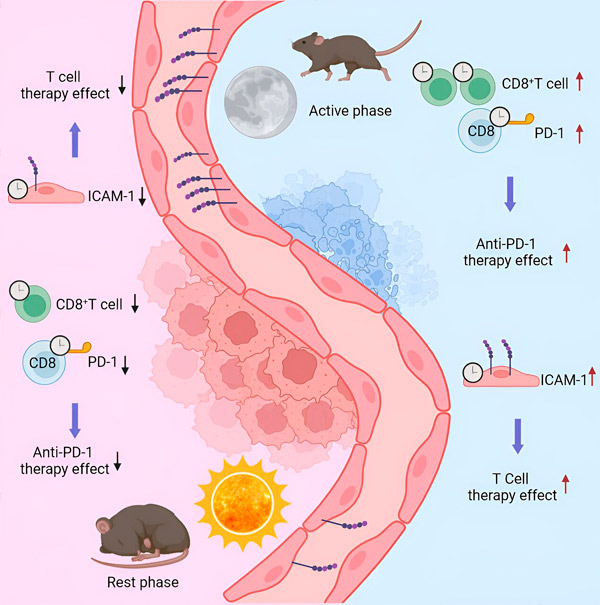New publications
Importance of immune system rhythmicity for tumor growth
Last reviewed: 02.07.2025

All iLive content is medically reviewed or fact checked to ensure as much factual accuracy as possible.
We have strict sourcing guidelines and only link to reputable media sites, academic research institutions and, whenever possible, medically peer reviewed studies. Note that the numbers in parentheses ([1], [2], etc.) are clickable links to these studies.
If you feel that any of our content is inaccurate, out-of-date, or otherwise questionable, please select it and press Ctrl + Enter.

By studying modifications of the immune system of tumours throughout the day, scientists from the University of Geneva and the Ludwig Maximilian University of Munich demonstrate their impact on the diagnosis and treatment of patients.
The most promising anti-tumor treatments currently available are immunotherapies, which aim to enhance the immune system of patients in the fight against cancer. However, despite the high effectiveness of these methods in some cases, their success is sometimes disappointing. How can this variability be explained?
In previous studies, a team from the University of Geneva (UNIGE) and the Ludwig Maximilian University of Munich (LMU) found that the rhythmicity of the immune system is important for tumor growth. The same scientists have now shown that the immune profile of tumors varies significantly depending on the time of day when biopsies are performed.
These temporary changes can lead to misdiagnosis and inappropriate treatment. In addition, some previously ignored therapeutic targets may prove key to fighting the disease. The findings, published in the journal Cell, could have significant implications for clinical care and drug discovery.
In 2022, a research team led by Christoph Scheiermann, professor in the Department of Pathology and Immunology and the Center for Inflammation Research at the UNIGE Faculty of Medicine and the University of Munich, observed an unexpected phenomenon: the growth and severity of tumors were linked to the circadian rhythm of immune cells. “But to use these results in a clinical context, we needed to understand their details in a model close to reality,” says Scheiermann.
To do this, the scientists injected a group of mice with melanoma cells and then collected the resulting tumors at different times of day two weeks later. Depending on the time of day and, therefore, on the animal’s immune activation, the number of immune cells, as well as their type and characteristics, varied significantly. This may have important implications in clinical settings.

Source: Cell (2024). DOI: 10.1016/j.cell.2024.04.015
"In the hospital, patients undergo a biopsy to identify the tumor and its immune characteristics," explains Scheierman. "Treatment, and in particular immunotherapy, is then determined based on this assessment. Now, depending on the timing of the biopsy, the number of infiltrated immune cells can be very high — and the tumor is classified as 'hot' — or very low ('cold'), even though it is the same tumor. Doing a biopsy at the wrong time can lead to an incorrect diagnosis."
A look at the timing of immunotherapies
To get as close to clinical reality as possible, the scientists applied two approved and widely used treatments to their groups of mice: CAR-T cells (engineered specifically to recognize and target tumor-specific proteins) and immune checkpoint inhibitors, which suppress the immune system's natural brakes to boost its activation against tumors.
"When given at the wrong time, these treatments had no effect. When given at the right time, the tumor burden could be significantly reduced," Scheierman explains. "The number of immune cells present or absent in the tumor is a factor, but so are their characteristics and behavior."
Indeed, depending on the modulation of the molecular elements used to create these treatments, the timing of their application becomes crucial. At the right time, the cells to be destroyed are immediately recognized. At the wrong time, the target molecules are expressed at a lower level and the drug has no effect.
Adaptation of schedules and treatment methods
These studies in mice are supported by analyses of patient survival rates following immunotherapies. Morning treatment – at the peak of immune activation in humans – is systematically associated with better survival rates. Studies are planned to assess the impact of altering the timing of screening and treatment on patients. Other projects will explore potential drug targets that have been under-appreciated so far.
Moreover, these discoveries about immune rhythms have even broader implications: in terms of personalized medicine, on the one hand, to adapt therapeutic approaches to the temporal profiles of patients (10-20% of people have a biological rhythm that does not coincide with the general population), and in the context of other pathologies, especially autoimmune diseases.
